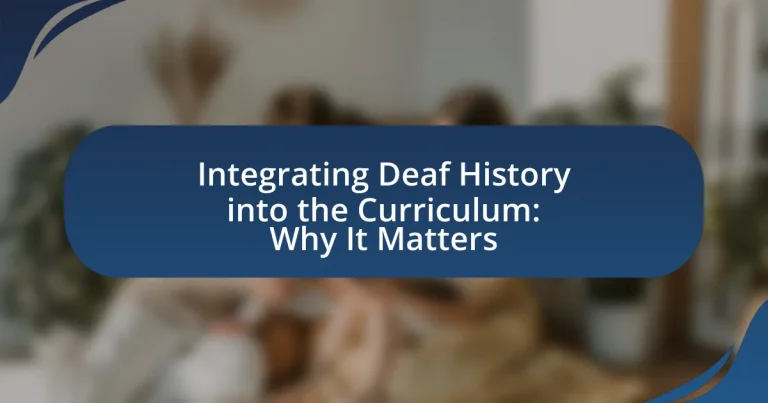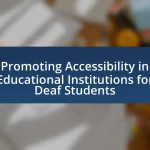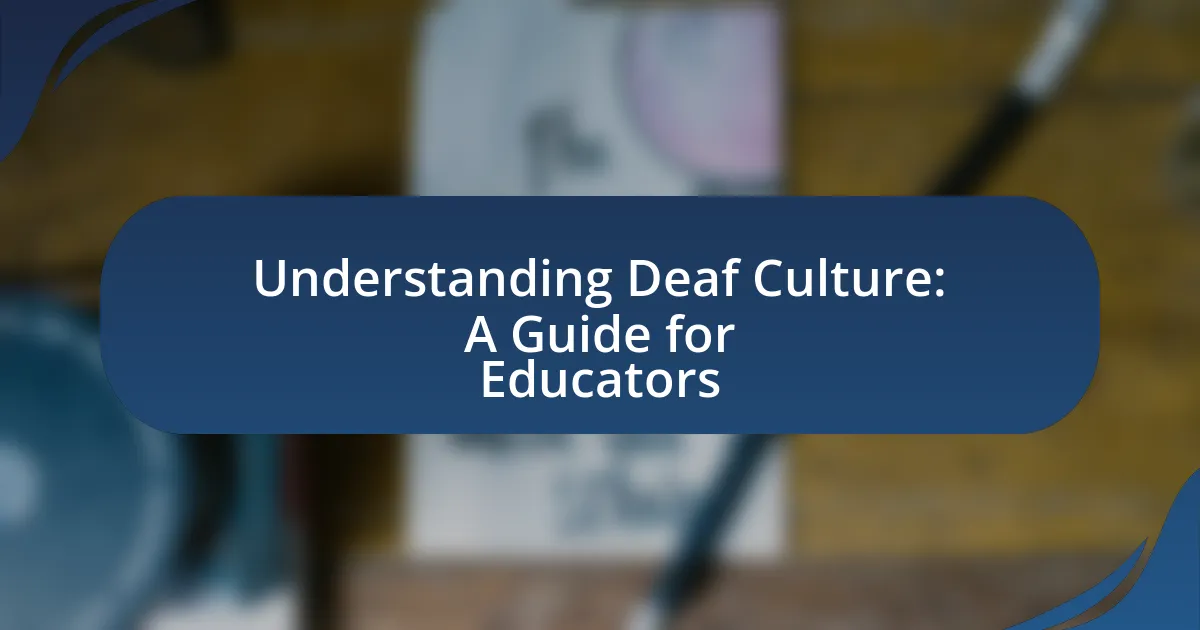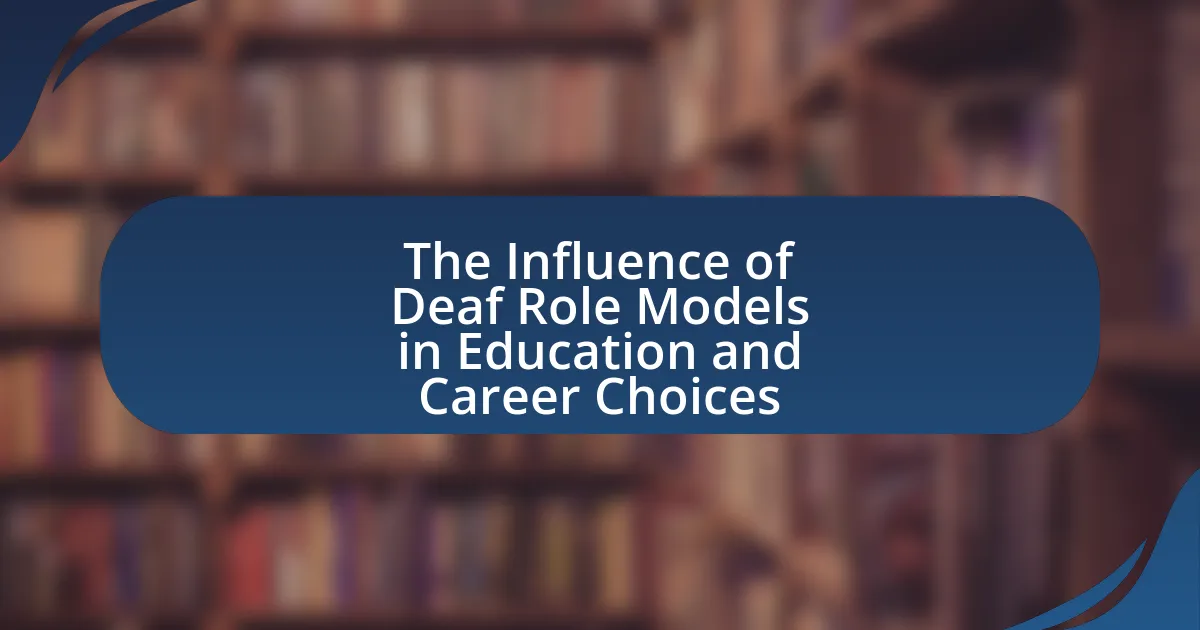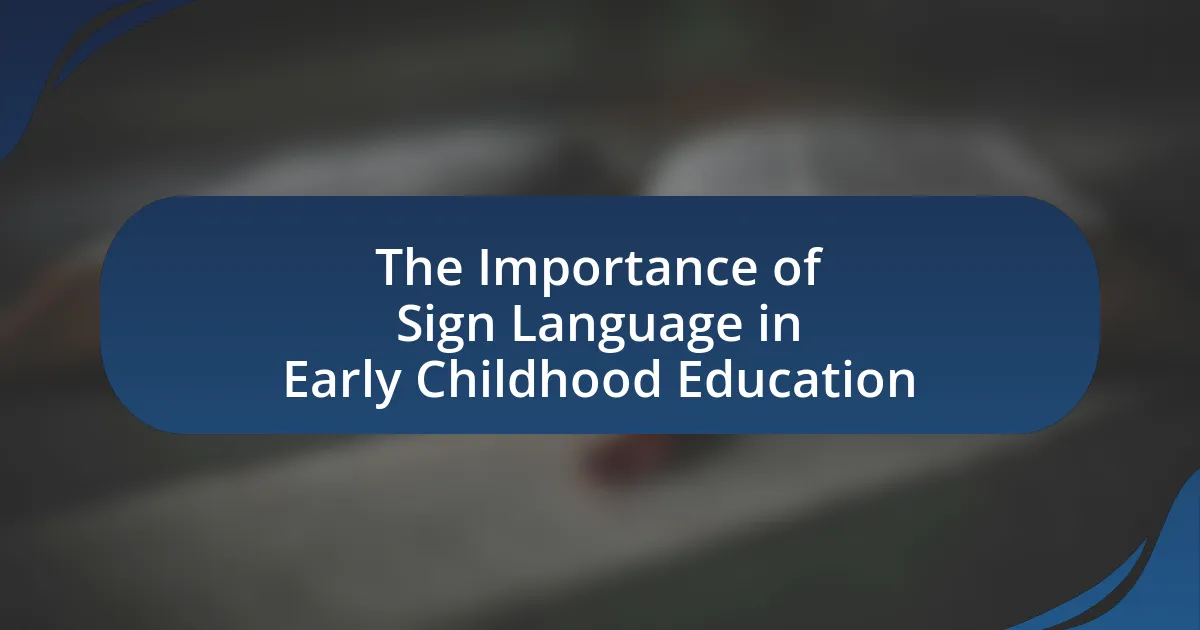Integrating Deaf History into the Curriculum focuses on the importance of including the experiences and contributions of Deaf individuals in educational programs. This integration aims to foster inclusivity, enhance cultural awareness, and challenge misconceptions about Deaf culture. Key historical events, such as the establishment of American Sign Language and the Deaf President Now movement, are highlighted to illustrate the significance of Deaf history in shaping societal understanding. The article also addresses the challenges educators face in teaching Deaf history and offers effective strategies and resources for overcoming these barriers, ultimately promoting a more diverse and inclusive educational environment.
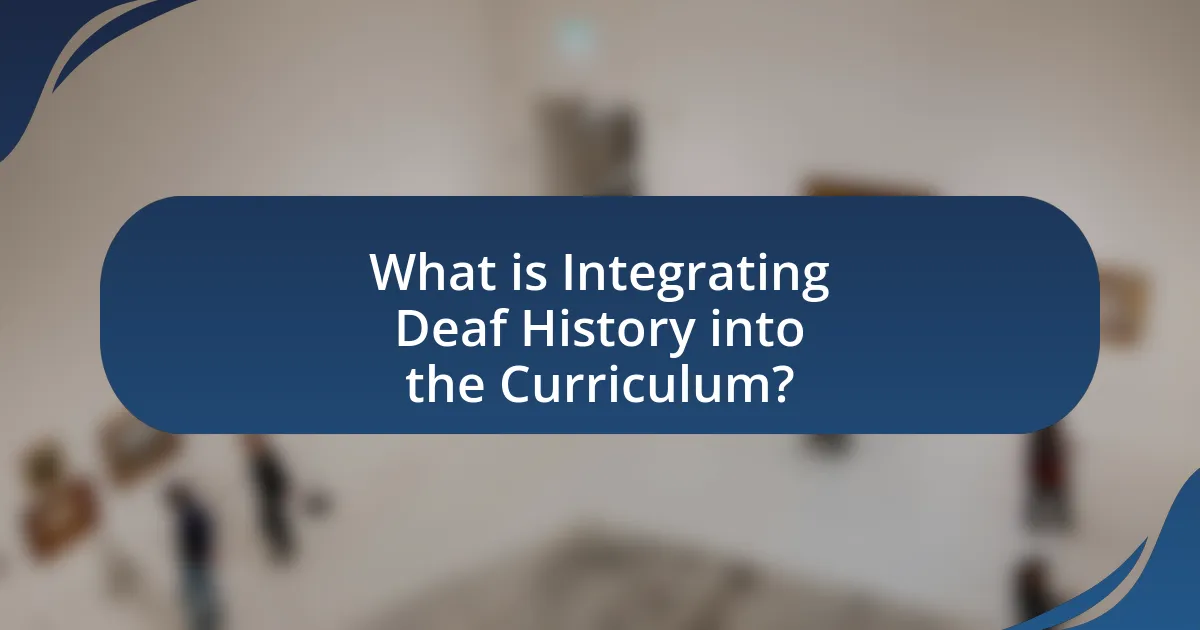
What is Integrating Deaf History into the Curriculum?
Integrating Deaf History into the Curriculum involves incorporating the experiences, contributions, and perspectives of Deaf individuals and communities into educational programs. This integration aims to provide a more inclusive and accurate representation of history, acknowledging the cultural and social significance of Deaf history. For instance, the establishment of American Sign Language as a legitimate language and the impact of the Deaf community in advocating for civil rights are critical elements that highlight the importance of Deaf history in shaping societal understanding. By including these narratives, educators can foster greater awareness and appreciation of diversity, ultimately enriching the learning experience for all students.
Why is it important to include Deaf history in educational settings?
Including Deaf history in educational settings is important because it fosters understanding and respect for Deaf culture and the contributions of Deaf individuals throughout history. By integrating Deaf history into the curriculum, students gain insights into the struggles and achievements of the Deaf community, such as the establishment of American Sign Language and the impact of the Deaf President Now movement in 1988, which highlighted the need for representation and equality. This knowledge promotes inclusivity and challenges misconceptions about Deaf individuals, ultimately enriching the educational experience for all students.
What are the key events in Deaf history that should be highlighted?
Key events in Deaf history that should be highlighted include the establishment of the first permanent school for the Deaf in the United States, the American School for the Deaf, founded in 1817 by Thomas Gallaudet and Laurent Clerc. This event marked a significant advancement in education for Deaf individuals. Another pivotal moment is the Milan Conference of 1880, where the use of sign language in education was largely rejected, leading to a decline in sign language use in schools for many years. The recognition of American Sign Language (ASL) as a legitimate language in the 1960s, particularly through the work of linguist William Stokoe, further transformed perceptions of Deaf culture and language. Additionally, the passage of the Americans with Disabilities Act (ADA) in 1990 was crucial in ensuring civil rights and accessibility for Deaf individuals. These events collectively illustrate the evolution of Deaf education, language, and rights, underscoring their importance in the broader context of Deaf history.
How does Deaf history contribute to a more inclusive curriculum?
Deaf history contributes to a more inclusive curriculum by providing diverse perspectives and experiences that enrich educational content. Incorporating Deaf history allows students to understand the cultural, social, and political contributions of the Deaf community, fostering empathy and awareness. For example, the establishment of American Sign Language as a legitimate language and the recognition of Deaf culture highlight the importance of linguistic diversity and cultural identity. This inclusion not only validates the experiences of Deaf individuals but also promotes a broader understanding of human rights and accessibility issues, which are essential in contemporary education.
What challenges exist in integrating Deaf history into the curriculum?
Integrating Deaf history into the curriculum faces several challenges, primarily due to a lack of awareness and resources. Many educators are not familiar with Deaf history, leading to insufficient representation in educational materials. Additionally, existing curricula often prioritize mainstream narratives, marginalizing the experiences and contributions of Deaf individuals. Research indicates that only a small percentage of educational institutions include comprehensive Deaf history, which limits students’ understanding of this important cultural perspective. Furthermore, the absence of trained educators who are proficient in both Deaf culture and history exacerbates these challenges, making it difficult to effectively teach this subject.
What misconceptions about Deaf culture hinder its inclusion?
Misconceptions about Deaf culture that hinder its inclusion include the belief that Deaf individuals cannot communicate effectively and the assumption that they all want to be “fixed” or cured. These misconceptions stem from a lack of understanding of sign language and the rich cultural identity of the Deaf community. For instance, research indicates that sign language is a fully developed language with its own grammar and syntax, enabling effective communication among Deaf individuals. Additionally, the notion that Deaf people seek to assimilate into hearing culture overlooks the value they place on their unique cultural heritage, which includes shared experiences and community. Such misconceptions can lead to exclusionary practices in educational settings and societal interactions, ultimately impeding the integration of Deaf history and culture into broader curricula.
How can educators overcome barriers to teaching Deaf history?
Educators can overcome barriers to teaching Deaf history by incorporating diverse teaching methods that engage students and promote accessibility. Utilizing visual aids, sign language resources, and interactive activities can enhance understanding and retention of Deaf history. Research indicates that inclusive teaching practices, such as the use of Deaf role models and culturally relevant materials, significantly improve student engagement and learning outcomes. For instance, studies show that when Deaf history is presented through multimedia and storytelling, it resonates more with students, fostering a deeper connection to the content.
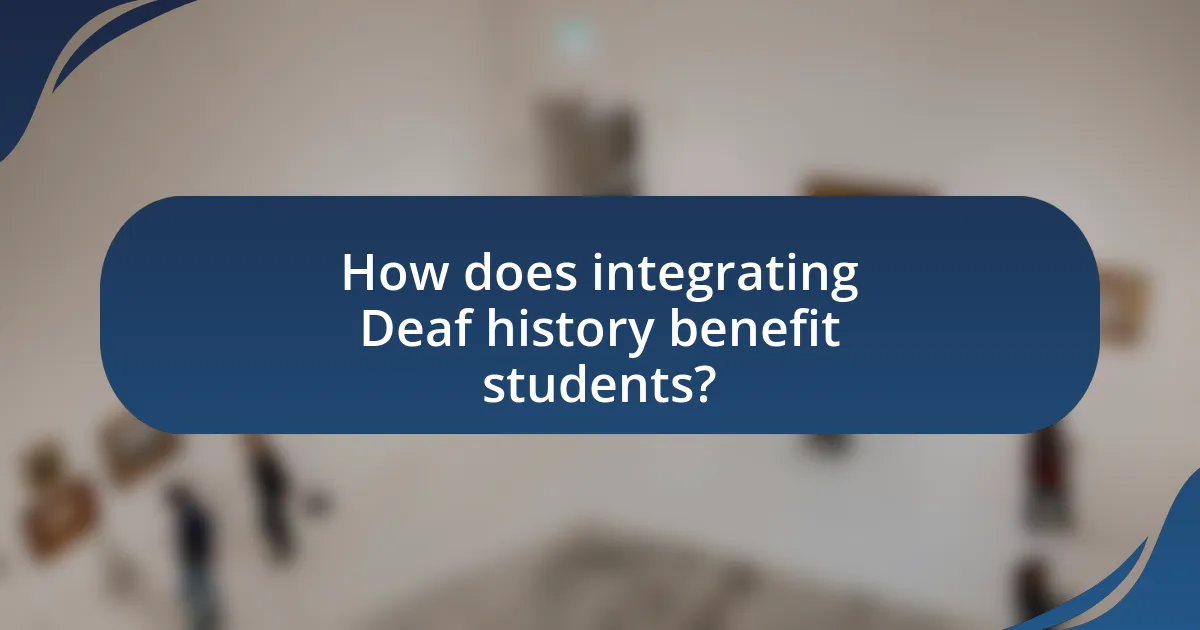
How does integrating Deaf history benefit students?
Integrating Deaf history benefits students by fostering inclusivity and enhancing cultural awareness. This integration allows students to understand the rich contributions of Deaf individuals to society, such as the establishment of American Sign Language and the advocacy for Deaf rights, which have shaped educational policies and social perceptions. Research indicates that exposure to diverse histories, including Deaf history, promotes empathy and reduces prejudice among students, leading to a more harmonious classroom environment. For instance, studies show that students who learn about different cultural narratives, including those of the Deaf community, demonstrate improved social interactions and a greater appreciation for diversity.
What impact does Deaf history have on student identity and self-esteem?
Deaf history significantly influences student identity and self-esteem by fostering a sense of belonging and cultural pride among Deaf students. When students learn about the achievements and struggles of the Deaf community, such as the establishment of American Sign Language and the advocacy for Deaf rights, they develop a stronger connection to their identity. Research indicates that understanding one’s cultural history can enhance self-esteem; for instance, a study by Lang and Meath-Lang (2011) found that Deaf students who engaged with Deaf history reported higher self-worth and a more positive self-image. This connection to a rich cultural heritage empowers students, helping them navigate societal challenges and affirm their identity within both the Deaf and hearing communities.
How does learning about Deaf history foster empathy among hearing students?
Learning about Deaf history fosters empathy among hearing students by providing them with insights into the challenges and triumphs of the Deaf community. This understanding helps hearing students recognize the social injustices faced by Deaf individuals, such as discrimination and exclusion from mainstream society. For example, the historical context of the Milan Conference of 1880, which banned sign language in education, illustrates the impact of oppressive policies on Deaf culture and identity. By studying these events, hearing students can develop a deeper appreciation for diversity and the importance of inclusion, ultimately leading to greater empathy and advocacy for marginalized groups.
What role does Deaf history play in promoting diversity and inclusion?
Deaf history plays a crucial role in promoting diversity and inclusion by highlighting the unique cultural, linguistic, and social contributions of the Deaf community. This history showcases the resilience and achievements of Deaf individuals, such as the establishment of schools for the Deaf in the 19th century and the recognition of American Sign Language as a legitimate language, which fosters understanding and respect for diverse communication methods. By integrating Deaf history into educational curricula, students learn about the importance of inclusivity and the value of different perspectives, thereby enhancing social cohesion and reducing stigma against individuals with disabilities.
How can integrating Deaf history enhance critical thinking skills?
Integrating Deaf history enhances critical thinking skills by providing diverse perspectives that challenge dominant narratives. This inclusion encourages students to analyze historical events through the lens of Deaf culture, fostering empathy and understanding of different social contexts. For instance, studying the impact of the 1880 Milan Conference, which marginalized sign language, prompts critical examination of language rights and educational equity. Such analysis cultivates the ability to question assumptions, evaluate sources, and draw connections between historical events and contemporary issues, thereby strengthening overall critical thinking capabilities.
What analytical skills are developed through studying Deaf history?
Studying Deaf history develops critical analytical skills such as contextual analysis, comparative analysis, and critical thinking. Contextual analysis enables individuals to understand the social, cultural, and political factors that have shaped the Deaf community’s experiences over time. For instance, examining the impact of the Milan Conference of 1880 reveals how policies affected Deaf education and identity. Comparative analysis allows for the evaluation of different historical narratives within Deaf history, fostering an understanding of diverse perspectives. Critical thinking is enhanced as students assess the implications of historical events on contemporary issues faced by the Deaf community, such as advocacy for rights and accessibility. These skills are essential for interpreting complex historical data and understanding its relevance today.
How does Deaf history encourage students to question societal norms?
Deaf history encourages students to question societal norms by highlighting the struggles and achievements of the Deaf community, which challenges prevailing misconceptions about disability and communication. For instance, the establishment of American Sign Language as a legitimate language in the 1960s demonstrated that Deaf individuals possess their own culture and identity, contradicting the notion that they are merely “disabled” or “less than.” This historical context prompts students to critically analyze how society defines ability and communication, fostering a deeper understanding of diversity and inclusion. By examining events such as the Deaf President Now movement in 1988, students learn about activism and the fight for equal rights, which further inspires them to question and challenge societal standards that marginalize various groups.
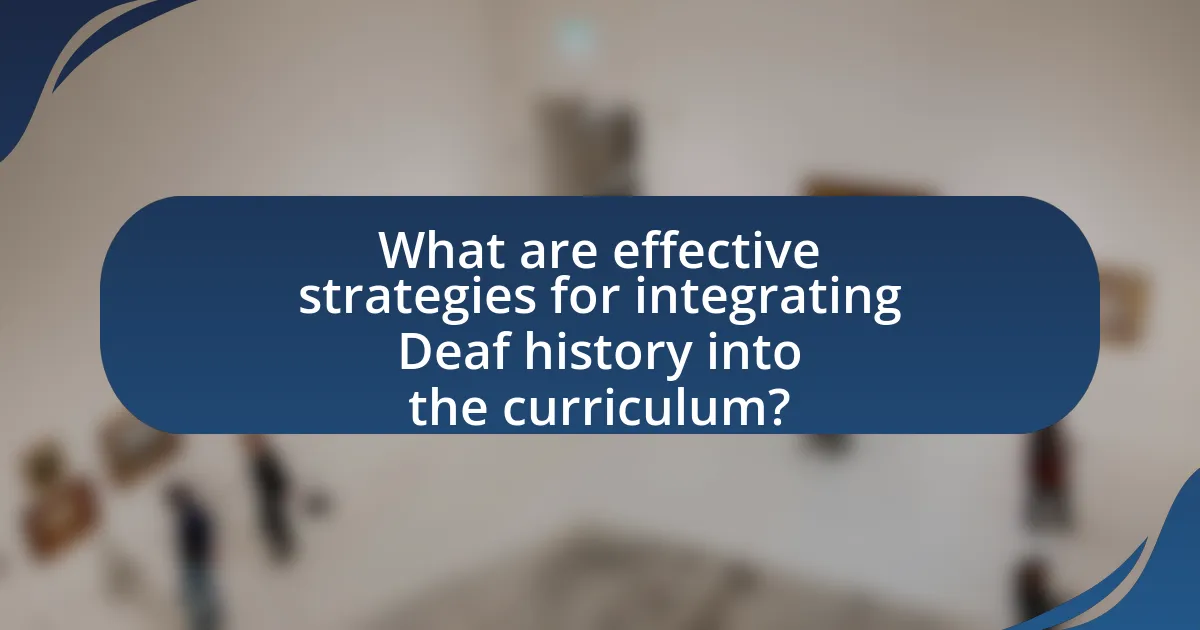
What are effective strategies for integrating Deaf history into the curriculum?
Effective strategies for integrating Deaf history into the curriculum include incorporating Deaf culture and historical events into lesson plans, utilizing multimedia resources such as documentaries and interviews with Deaf individuals, and fostering partnerships with local Deaf organizations. These strategies enhance students’ understanding of the contributions and experiences of Deaf individuals throughout history, such as the establishment of schools for the Deaf in the 19th century and the impact of the Deaf President Now movement in 1988. By including these elements, educators can create a more inclusive and comprehensive educational experience that acknowledges the significance of Deaf history in broader societal contexts.
What resources are available for educators to teach Deaf history?
Educators can access a variety of resources to teach Deaf history, including books, online courses, and multimedia materials. Notable books such as “Deaf History Unveiled” by John V. Van Cleve and “A Place of Their Own: Creating the Deaf Community in America” by Susan Burch provide historical context and narratives. Online platforms like the National Deaf History Museum offer virtual exhibits and educational materials. Additionally, organizations such as the American Society for Deaf Children provide lesson plans and teaching guides tailored to Deaf history. These resources are essential for integrating Deaf history into the curriculum, promoting awareness and understanding of Deaf culture and contributions.
How can multimedia tools enhance the teaching of Deaf history?
Multimedia tools can enhance the teaching of Deaf history by providing diverse and engaging formats that cater to various learning styles. These tools, such as videos, interactive presentations, and digital storytelling, allow educators to present historical events and figures in a visually compelling manner, making the content more accessible and relatable. For instance, the use of sign language videos can effectively communicate Deaf narratives, while interactive timelines can illustrate significant milestones in Deaf history. Research indicates that incorporating multimedia in education increases retention rates and student engagement, as evidenced by a study published in the Journal of Educational Psychology, which found that students who learned through multimedia resources scored 30% higher on retention tests compared to those who used traditional methods.
What role do community partnerships play in curriculum integration?
Community partnerships play a crucial role in curriculum integration by providing resources, expertise, and real-world connections that enhance educational content. These partnerships facilitate the inclusion of diverse perspectives, such as those from the Deaf community, which enriches the curriculum and fosters a more inclusive learning environment. For instance, collaboration with local Deaf organizations can lead to the development of specialized programs that reflect Deaf culture and history, ensuring that students gain a comprehensive understanding of the subject matter. Research indicates that schools with strong community ties often see improved student engagement and achievement, highlighting the effectiveness of such partnerships in educational settings.
How can teachers assess student understanding of Deaf history?
Teachers can assess student understanding of Deaf history through a combination of formative assessments, project-based learning, and reflective writing. Formative assessments, such as quizzes and discussions, allow teachers to gauge students’ grasp of key concepts and events in Deaf history, including significant milestones like the establishment of Gallaudet University in 1864. Project-based learning encourages students to explore Deaf culture and history through research projects, presentations, or creative works, fostering deeper engagement and understanding. Reflective writing assignments, where students articulate their thoughts on the impact of historical events on the Deaf community, provide insight into their comprehension and personal connections to the material. These methods collectively ensure a comprehensive evaluation of students’ knowledge and perspectives on Deaf history.
What types of assessments are most effective for this subject?
Formative assessments are most effective for integrating Deaf history into the curriculum. These assessments, such as reflective journals, group discussions, and project-based learning, allow educators to gauge students’ understanding and engagement with the material in real-time. Research indicates that formative assessments enhance student learning by providing immediate feedback and opportunities for self-reflection, which is crucial in understanding the complexities of Deaf history and culture. For example, a study by Black and Wiliam (1998) found that formative assessment practices significantly improve student achievement across various subjects, including history.
How can feedback be used to improve teaching methods in Deaf history?
Feedback can be used to improve teaching methods in Deaf history by systematically gathering insights from students and educators to identify effective practices and areas needing enhancement. For instance, student evaluations can reveal which teaching strategies resonate most, such as the use of visual aids or interactive discussions, leading to adjustments that better engage learners. Research indicates that incorporating student feedback into curriculum design can enhance educational outcomes; a study by Hattie and Timperley (2007) in “Review of Educational Research” highlights that feedback significantly influences student achievement. By analyzing this feedback, educators can refine their approaches, ensuring that Deaf history is taught in a manner that is both relevant and impactful.
What best practices should educators follow when teaching Deaf history?
Educators should prioritize inclusivity and authenticity when teaching Deaf history. This involves incorporating Deaf perspectives and narratives, ensuring that materials reflect the experiences of Deaf individuals and communities. For instance, using primary sources such as autobiographies and interviews from Deaf historians can provide firsthand accounts that enrich the curriculum. Additionally, educators should engage with Deaf culture through collaboration with Deaf organizations and community members, which fosters a deeper understanding of the historical context and significance of Deaf history. Research indicates that inclusive teaching practices enhance student engagement and learning outcomes, as seen in studies conducted by the National Deaf Center on Postsecondary Outcomes, which highlight the importance of representation in educational settings.
